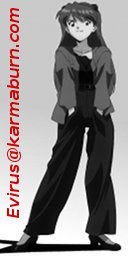|
|
Blog Archives:
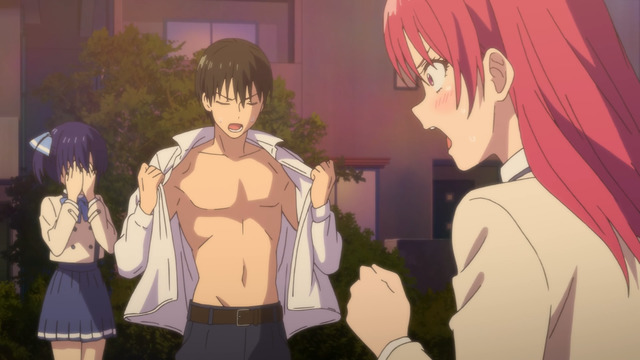
It's a pragmatic solution. Don't just dismiss it out of hand.
Not having a whole lot else to watch from the Summer 2021 anime season, I decided to give Kanojo mo Kanojo (Girlfriend, Girlfriend) a try on a goof. It turns out it's sort of fantastic. I initially assumed it was going to another one of those dreary harem comedies with a loathsome male protagonist surrounded by multiple girls who are entirely out of his league and yet inexplicably attracted to him. Or that it was going to be on of those dreary harem comedies where Potato-kun is actually sort of an all right dude, but is inexplicably incapable of noticing that every girl he comes into contact with keeps throwing her panties at him. It turns out Kanojo mo Kanojo is neither of those things. Rather, it's got some manner of Möbius strip horseshoe theory thing going on where all the environmental factors and character decisions that should be working to the show's detriment end up making it better.
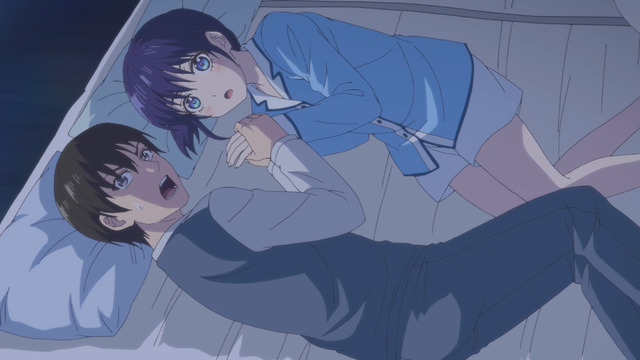
Busted.
It's no accident Kanojo mo Kanojo is working out this way. The recurring focus of the show's various dilemmas is on an unending series of incorruptibly honest decisions to pursue uncompromising choices that should result in self-destructive consequences by any reasonable objective standard. And yet it all continues to work out. I can't vouch for the manga source material, but the anime embraces the absurdity of its premise and absolutely succeeds in its execution.

Never gonna happen.
Significantly, there is no hint of melodrama. That is something Girlfriend, Girlfriend really cannot afford. If Kanojo mo Kanojo ever decides to examine the consequences and societal frictions associated with polyamorous relationships, or attempts to position the various love interests against each other from hostile postures of envy or jealousy, it will do so at its peril. There had also better not be any of that typical harem comedy bullshit where a series gets its viewers to root for one of the girls to "win." (If it does, the erstwhile winner will probably be First Girl Childhood Friend, even though she has nothing in her favor compared to her rivals except for her hair.)
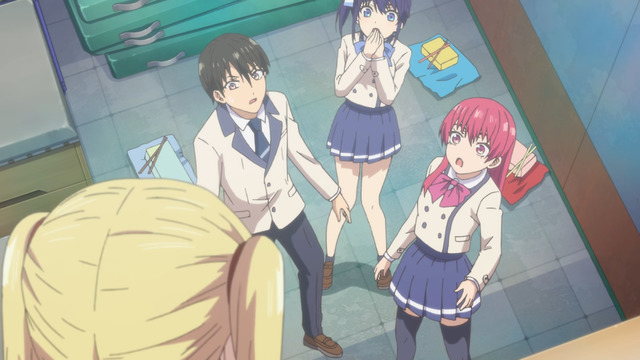
Busted.
Even though I only started watching Girlfriend, Girlfriend a short while ago, it did not take long before I caught up. There are currently 10 episodes out so far and only two to go. Since the source manga still seems to be running (I think eight volumes are out), a non-ending ending to the anime is probably basically guaranteed. I don't know how far Kanojo mo Kanojo can take its premise without getting derailed, but I would be in favor of additional seasons if it can keep up the show's high-intensity, relentless pace episode after episode without running out of steam.
Posted in GIRL NEXT DOOR, Kanojo mo Kanojo | Tags: Bend Her Over a Kotatsu, Built for Sin, Childhood Friend, Comedy, Fan Service, Hair, Harem Comedy, Initial impressions, Love Triangle, Manga, Plying Girls, Romance, Season Introduction, tsundere, Unrequited Love | Permanent Link
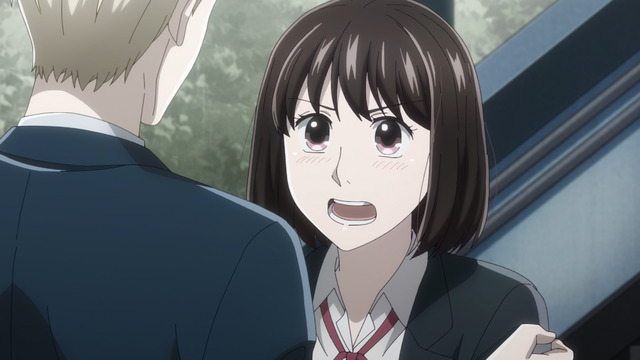
They're not flirting.
I started the Spring 2021 season with an entry covering both Koi to Yobu ni wa Kimochi Warui (It's Disgusting to Call This Love or KoiKimo) and Hige wo Soru. Soshite Joshikousei wo Hirou. (I Shaved. Then I Brought a High School Girl Home. or HigeHiro), so I guess I should have a post wrapping them up as well. I found KoiKimo to be a better series, perhaps because of its straightforward story. It also helps that KoiKimo leaves Ichika in control of her fate. It is ultimately Ichika's decision whether her relationship with Ryo will advance or not.
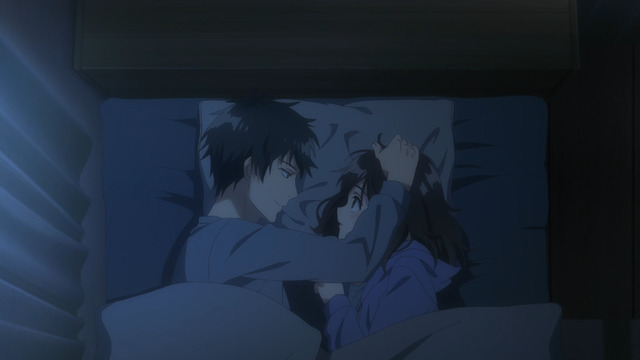
Platonic head pat.
Sayu does not have this luxury in HigeHiro. Maybe it's disingenuous to claim HigeHiro is about Yoshida "looking for something attractive to save" (my apologies to Liz Phair), but replace Yoshida's name here with "the audience's surrogate," and maybe it's not far off the mark. KoiKimo and HigeHiro both ended up where I expected, but Sayu had much less say over the path she took to get there.
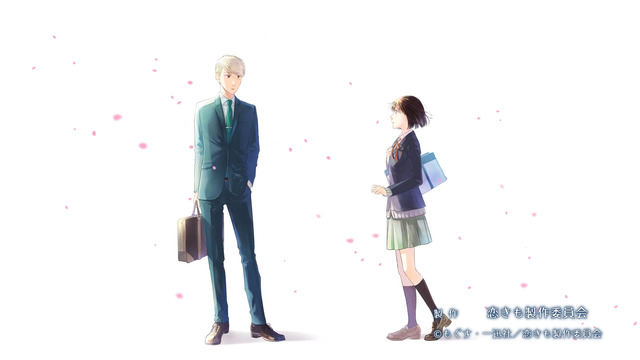
Making the end credits look more like the manga art was a nice touch.
In contrast, KoiKimo is an honest romance. There is no real mystery whether Ichika and Ryo will actually end up together or not, even though KoiKimo does introduce rival love interests for both leads. Moreover, the rivals are genuinely more sensible partners from every objective metric. However, the most obvioius impediment—the age gap between Ichika and Ryo—is never depicted as a meaningful obstacle. When it is finally viewed as a problem, its solution is entirely unsurprising.
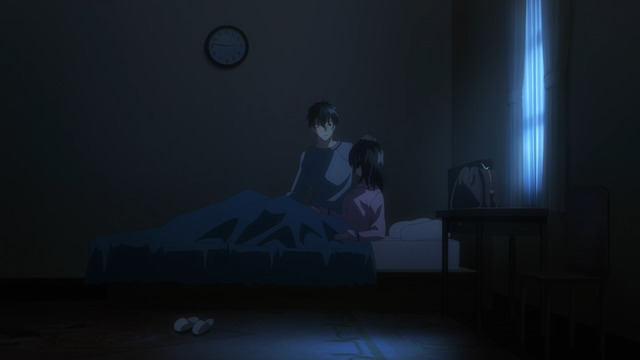
Platonic head pat.
The solutions to the challenges presented in HigeHiro are also fairly obvious, but the series insists on pantomiming a number of unconvincing feints. They're unconvincing because Sayu basically has no flaws, and Yoshida clearly feels something for her. He never has a reason to turn her away, and Sayu's rivals for Yoshida's attention are dubious love interests who quickly end up supporting Sayu anyway.
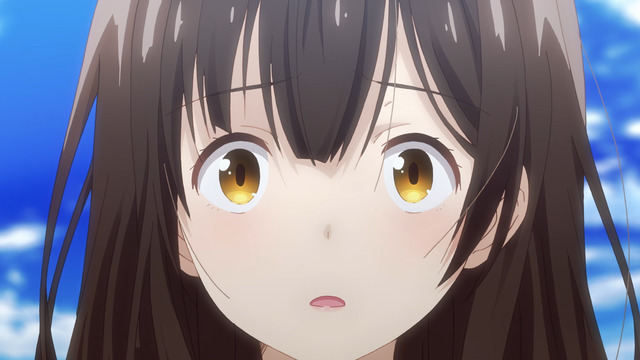
Relax, Sayu. Wonder Eggs are only 500 yen each.
In fact, Sayu's true adversaries are her lack of self-worth, her family's disinterest in her welfare, and the story's insistence at making Yoshida obtuse. Yoshida's behavior is baffling in HigeHiro, and not just because he denies being attracted to the sexually available high school girl living with him. Yoshida's behavior is baffling because he's willing to accept immediately on faith that Sayu would be better off returning to her home, without ever examining even the slightest bit the reasons why she ran away in the first place. It seems irresponsible to not at least contemplate the myriad awful situations that potentially compel teenagers to leave home and offer sex to strangers just to survive.
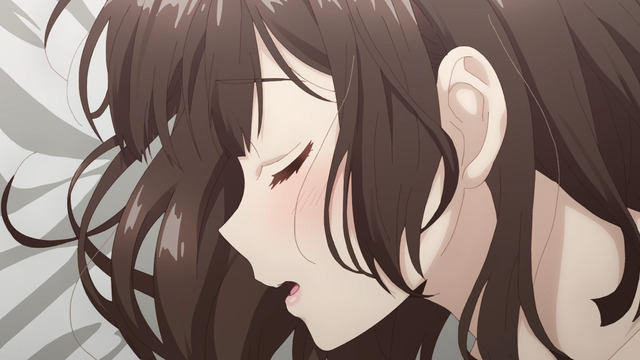
HigeHiro showed Sayu orgasming on screen.
Of course, the real reason Yoshida never asks is because the story can't let him or the audience know before the narrative is ready. It turns out the unpleasant situation Sayu fled wasn't that bad, but that's the case only because HigeHiro insists on rehabilitating its antagonists immedately after introducing them. This sort of cowardice is a significant weakness of HigeHiro, as it makes its conflicts fairly hollow. The challenges presented in KoiKimo are not intractable either, but at least they don't take on a fraudulent quality.
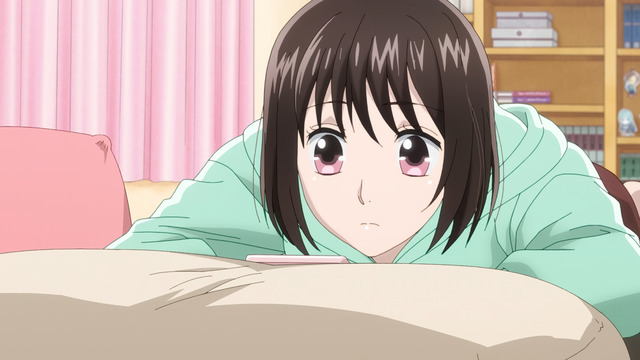
Ichika grew accustomed Ryo's nightly calls without realizing it.
KoiKimo succeeded by being forthright about its romance and committing to it unapologetically. In contrast, HigeHiro (like Yoshida himself) spends basically the entire series maintaining an unconvincing veneer of plausible deniability over whether or not Sayu is an actual love interest. At the risk of attracting accusations of being in favor of age-inappropriate pairings, I'm going to suggest HigeHiro does this to its detriment.
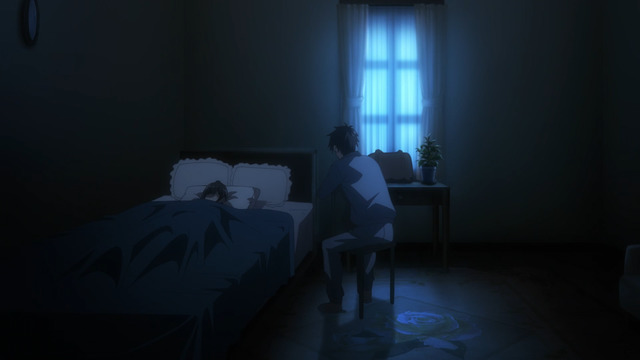
They had to put him in a chair watching her sleep
so people wouldn't insist they still fucked.
I suppose I can't speak for its source material, but the anime most certainly portrays Sayu as an eligible partner. Does HigeHiro provide Sayu with agency by having her test Yoshida's resolve each time she propositions him? Or does the series undermine Sayu's agency by presenting these moments solely so Yoshida can continue to rebuff her and showcase his unflagging integrity? I'm not answering this rhetorical, but I think we all know.
Posted in Hige wo Soru. Soshite Joshikousei wo Hirou., Koi to Yobu ni wa Kimochi Warui | Tags: 16-year-old love interests, Bad Things Happen to Good People, Bend Her Over a Kotatsu, Built for Sin, Christmas Cake, Compare and Contrast, Fan Service, Hanakana Distortion Field, Hanazawa Kana, Harem Comedy, Light Novels, Love Confessions, Love Triangle, Manga, May-December Romances, Plying Girls, Rape, Romance, Season Conclusion, Sex, Spoilers, Spring 2021, tsundere, Unrequited Love | Permanent Link
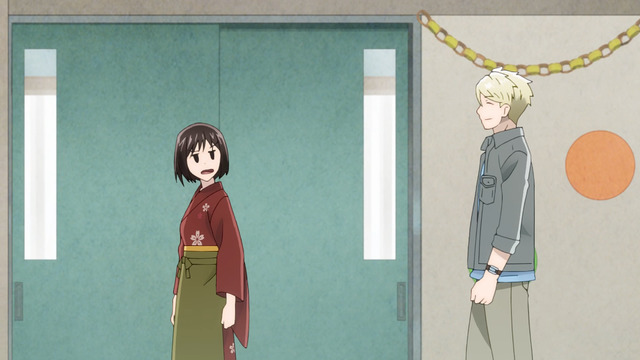
Stalker distancing.
News that the Spring 2021 anime season would feature TWO shows about adult men paired with high school girls created ripples across the Twitter, but even this mild outrage waned after viewers discovered neither show was as torrid as anticipated. Descriptions of Koi to Yobu ni wa Kimochi Warui (It's Disgusting to Call This Love, A.K.A. Koikimo) in particular concentrated on elements that ranged from misleading (characterizing its male lead as "a womanizer") to outright untruthful (e.g., calling him "sex-crazed...with a wandering eye for women"). At the risk of stereotyping too much, I suspect more attention should have been paid to the fact that the Koikimo manga is described as josei (i.e., for adult women) instead of seinen (i.e., for adult men who miss fucking teenage girls).
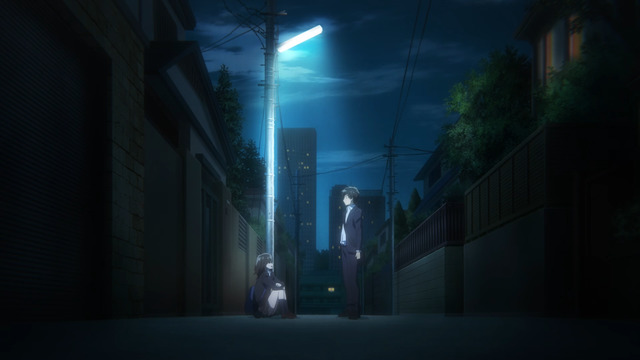
I was too bothered by Sayu's lack of luggage to make a Fate/stay night joke.
Curiously, Hige wo Soru. Soshite Joshikousei wo Hirou. (Higehiro: After Being Rejected, I Shaved and Took in a High School Runaway) seemed to attract less pre-season attention than Koikimo, but perhaps its original novels and manga adaption were already known well enough to deflect unwarranted speculation that it was going to be a smutty romp. This, despite its synopsis outright stating that its characters meet when the titular teenage girl, Sayu, offers sex in exchange for a place to stay. Instead, Higehiro is about a man, Yoshida, who insists he is not attracted to the JK crashing at his place. The series begins with Yoshida being rejected by his long-term crush (his boss at work, no less) who claims she is already seeing someone. He is so devastated that he seemingly does not even notice she was CLEARLY LYING.
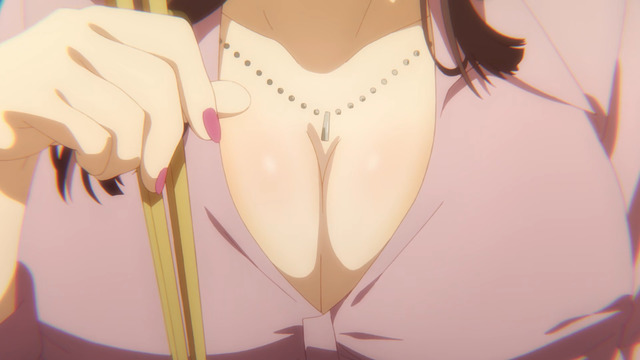
Dude, you're staring.
Higehiro also draws attention to Yoshida's insistence that he is not a "nice guy" for letting Sayu live with him without strings attached (unlike everyone else she has stayed with during her previous six months as a runaway), but rather that the other men she has known are despicable people. Yoshida also repeatedly insists he is not attracted to Sayu because he only likes women with large breasts, but then the show promptly undercuts him by immediately alerting (and repeatedly reminding) the viewer that Sayu's boobs are also comfortably big.
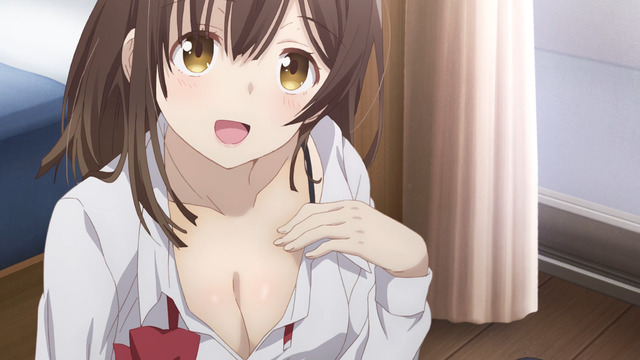
Higehiro even quantifies the comparison.
This is where I lose the ability to predict the path Higehiro will take. There is enough fan service and "male gaze" to the anime that we are obviously supposed to see Sayu as a legitimate love interest of Yoshida's, despite (or perhaps because of) his loud denials. But the show also retains the harem elements by keeping the CLEARLY LYING boss lady and deliberately slapdash co-worker near as potential romantic rivals. If I had to guess how this story ends, I would expect Yoshida's support to put Sayu on a path to success before re-uniting the two after a multi-year timeskip apart that has given Sayu time to become a self-sufficient adult with even bigger boobs than ever. Alternatively, we'll get a cop-out non-ending ending, potentially with all four of them living together for contrived reasons.
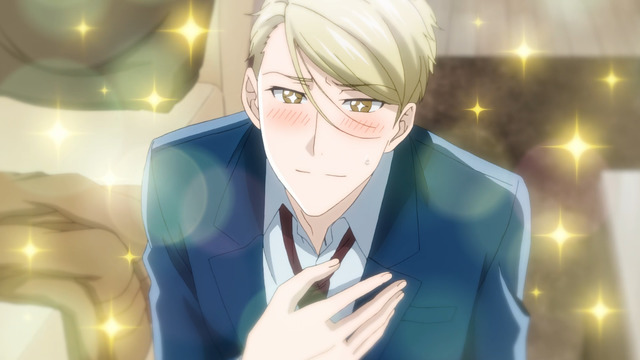
You can tell he's sincere because of the sparkles.
While Higehiro is about a man who denies being attracted to the teenage girl living with him, Koikimo is about a man openly and aggressively wooing a high school girl 10 years his junior. At this point, I think it is necessary to acknowledge the tropes that govern this story's boundaries. Ryo and Ichika meet by chance and a suspension bridge moment sparks his sudden obsession with Ichika, who is coincidentally classmates with Ryo's kid sister, Rio. Fortunately for Ryo, his sister not only approves of his infatuation with her friend, but even volunteers as his wingman to provide opportunities for him to get closer with Ichika.
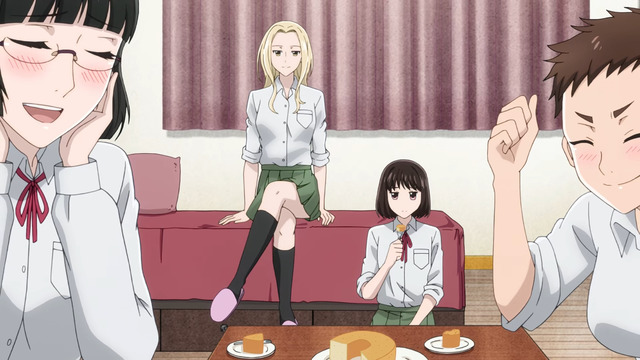
Rio's anime bed is made of concrete.
Moreover, Ichika's own mother approves of Ryo's courtship, despite Ichika's clear displeasure. It is probably worth pointing out that Ryo has apparently never had to pursue a love interest before. He is not a pick-up artist chasing after fresh prey. Instead, girls and women have thrown themselves at him his entire life (Ichika's and Rio's classmates all unanimously agree Ryo is exceptionally handsome), so this is an entirely new experience for him.
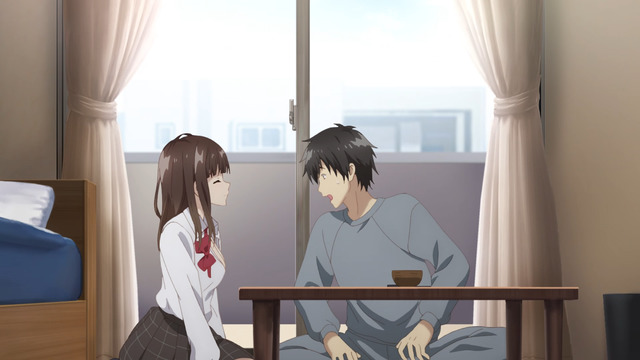
Dude, you're staring.
So what are Koikimo and Higehiro both missing? Lust. In the case of Koikimo, Ryo is clearly, genuinely smitten with Ichika, but he is arguably more drawn to her disinterest in him than he is to her physical appearance. Ichika is presented as being fairly unremarkable among her peers, and her own best friend describes her as "normal" (although at least one boy at her school has taken a liking to her). In the case of Higehiro, it takes three episodes of the show loudly signalling that Sayu is comely and sexually available before Yoshida finally admit he finds her attractive. However, his refusal to sleep with her is predicated on a critical, foundational cornerstone to the narrative's integrity, so I don't expect the story can too easily reverse this stance even if the audience comes to think he protests too much.

She is upset because she is pleased.
After four episodes of Koi to Yobu ni wa Kimochi Warui and three episodes of Hige wo Soru. Soshite Joshikousei wo Hirou., I enjoy Koikimo more than Higehiro. Neither series is especially realistic (although I could believe Higehiro, despite the melodrama, were it not for the CLEARLY LYING Christmas-cake boss lady and the co-worker who deliberately fucks up her work for Yoshida's attention), but I find Koikimo more amusing. I can't rule out the possibility that I'm simply more enamored of Ichika's seemingly endless barrage of disgusted faces than I am with Sayu's "pretty big for a high school girl" bosom, though.
Posted in Hige wo Soru. Soshite Joshikousei wo Hirou., Koi to Yobu ni wa Kimochi Warui | Tags: 16-year-old love interests, Bend Her Over a Kotatsu, Built for Sin, Christmas Cake, Compare and Contrast, Harem Comedy, Light Novels, Love Confessions, Love Triangle, Manga, May-December Romances, Plying Girls, Rape, Romance, Season Introduction, Sex, Spring 2021, tsundere, Twitter, Unrequited Love | Permanent Link
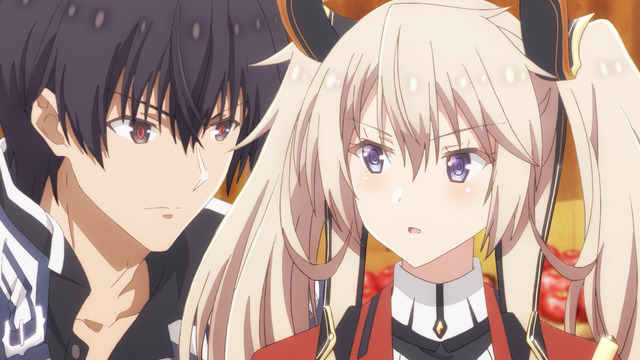
If you keep making eye contact like that, she's gonna do the thing.
I started watching Maou Gakuin no Futekigousha (The Misfit of Demon King Academy) because I like the way its character designer draws eyes. True story. (This is also why I watched Toji no Miko (Katana Maidens. But I digress.) As it turns out, the Maou Academy anime has stayed reasonably entertaining through its first nine episodes, and about in line with what I hoped for after the first two episodes.
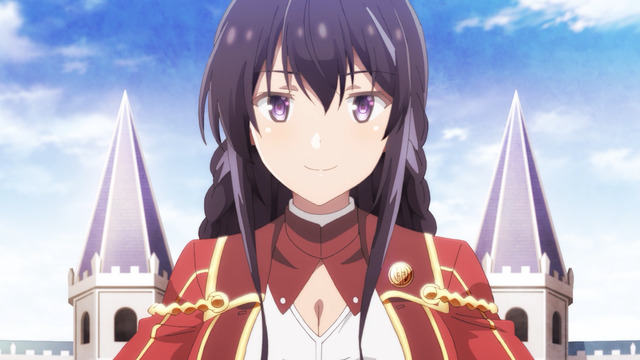
It took nine episodes to introduces this twin-braided character from the promo art.
One key to its success is having enough lore to keep the viewer guessing as to what's happened in the world during the two thousands years Anos was busy staying dead. Or rather, enough lore to make it interesting, but not so much lore that it becomes oppressingly sonorous. (Fate/stay night, I am looking in your direction.) I don't think anyone is going into Maou-kun Goes to Maou-kun School expecting the best thing ever, but anyone in the mood for casually lopsided fights and a fair amount of tsundere yammering has come to the right place.
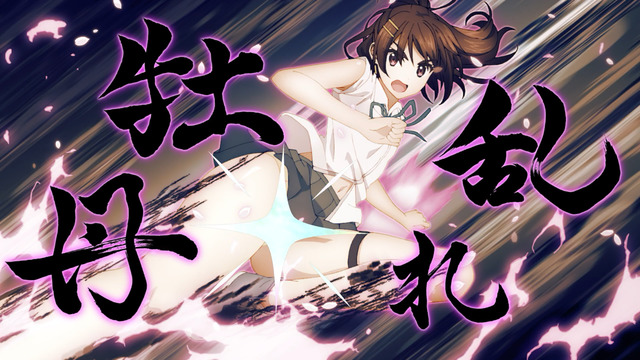
I don't know why they censored this. She's wearing panties.
Since I first introduced Maou Gakuin together with Dokyuu Hentai HxEros (SUPER HXEROS), I guess I should also include that I dropped HXEROS after five episodes. It is what it is, but there were other things I preferred to spend my time on instead.
Posted in Dokyuu Hentai HxEros, Maou Gakuin no Futekigousha | Tags: Built for Sin, Childhood Friend, Dropped Shows, Fan Service, Harem Comedy, Light Novels, Nudity, Sex, Summer 2020, Superlovely Character Designs, tsundere | Permanent Link
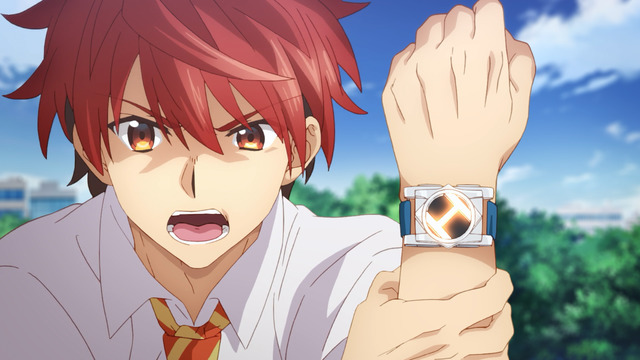
I bet this watch doesn't even keep time.
The Summer 2020 anime season is upon us, and the first shows I watched were Dokyuu Hentai HxEros (SUPER HXEROS) and Maou Gakuin no Futekigousha (The Misfit of Demon King Academy). These were not exactly shows I was looking forward to seeing, but they were among the ones first out the gate, so why not? As it turns out, neither are as bad as I might have feared, although I can't exactly call them good either.
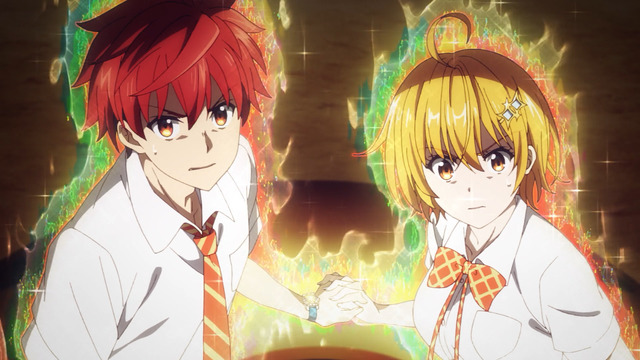
Ol' Red here is literally powered by this blonde girl's indefatigable libido.
In the case of Dokyuu Hentai HxEros, there have been multiple anime in the past that involved teenagers harnessing the power of their youth to battle various evildoers. Dakara Boku wa, Ecchi ga Dekinai. (So, I Can't Play H!) comes to mind, as does Hybrid × Heart Magias Academy Ataraxia (i.e., the other HxH anime—the one that is not Hunter x Hunter). SUPER HXEROS was actually sort of amusing thanks to its embrace of tokusatsu live-action tropes. The show is self-aware, but not to a negative extent.
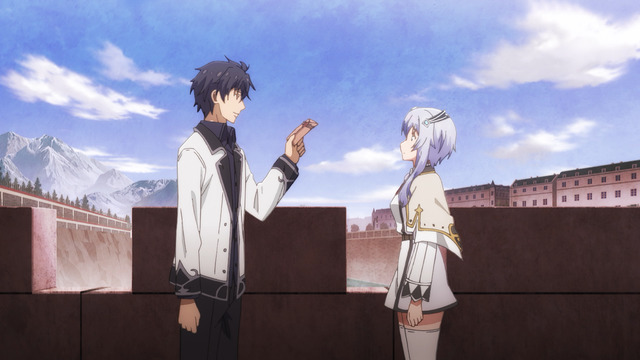
Picking up The Precious Thing is apparently a big deal in Misha's eyes.
I'm expecting Maou Gakuin no Futekigousha to be light-novel rubbish, but I genuinely appreciate that the first episode skipped the backstory and setup entirely, dropping the reader straight into the reincarnated demon king's first day at Evil Hogswarth. (Okay, fine, at a slightly eviler Hogswarth.) The characters at school are entirely forgettable so far, and exist mostly so the "misfit demon king" has various assholes he can easily defeat. (They totally have it coming.) His parents seem really dumb, but in a good-natured sort of way, so I'm willing to watch more. Overall, not a great start to the Summer 2020 anime season, but good enough for its first week.
Posted in Dokyuu Hentai HxEros, Hybrid × Heart Magias Academy Ataraxia, Maou Gakuin no Futekigousha | Tags: Built for Sin, Childhood Friend, Fan Service, First Episode, Harem Comedy, Light Novels, Season Introduction, Sex, Summer 2020, Superlovely Character Designs | Permanent Link

Not a whole lot of anime characters with freckles.
I would not call Gleipnir lewd even though its lead girl has spent most of the first five episodes with her clothes off. (The rest of the time, she's usually in the process of removing her clothes.) The show is lurid, though. Frankly, I'm finding this sort of extremely overt fan service rather refreshing. It's a nice contrast to some of the inflexible attitudes I seem to encounter on the Twitter occasionally. In any case, it's starting to look like Gleipnir actually has a lot going on. In fact, probably too much going on to wrap up in a single cours considering five episodes have already passed, and the show is only just now getting started with a plot of any sort.
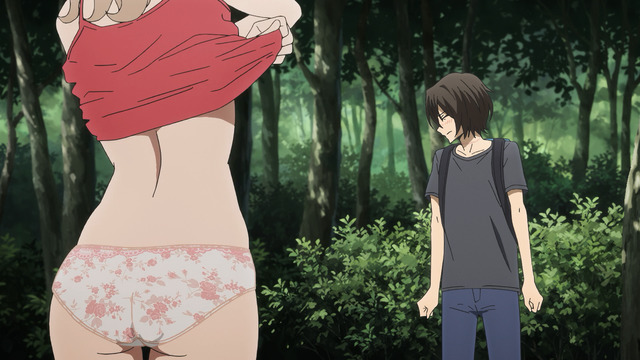
This is good way to get a lot of bug bites, Clair.
From the looks of it, the Gleipnir anime is also about to add a bunch of new characters (who won't necessarily live long). Seeing as how the original manga appears to still be ongoing, I'm guessing the anime is going to conclude with a non-ending ending unless it proves popular enough to get successive seasons. I don't know if I'm going to care about any of these new characters, but I'm hoping they'll bring more to the series than Potato-kun has so far. At least Clair is interesting. After all, she has gotten less suicidal and her brassieres are exquisitely detailed.
Posted in Gleipnir | Tags: Built for Sin, Girls With Guns, Manga, Season Introduction, Spring 2020 | Permanent Link
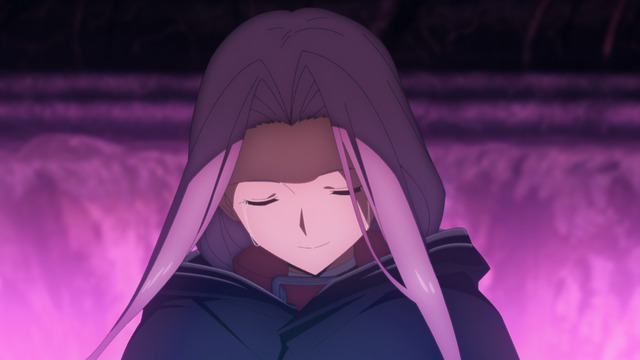
Ana is a good girl.
Firstly, I fully expected to find Fate/Grand Order: Zettai Majuu Sensen Babylonia (Fate/Grand Order: Absolute Demonic Front Babylonia) mostly incomprehensible, since I was basically ignorant about its lore aside from what I managed to glean via the Twitter and from the copious amounts of fan art devoted to the franchise. This did, indeed, turn out to be the case. It certainly does not help that Fate/Baby was episode seven within its underlying Fate GO game's narrative.
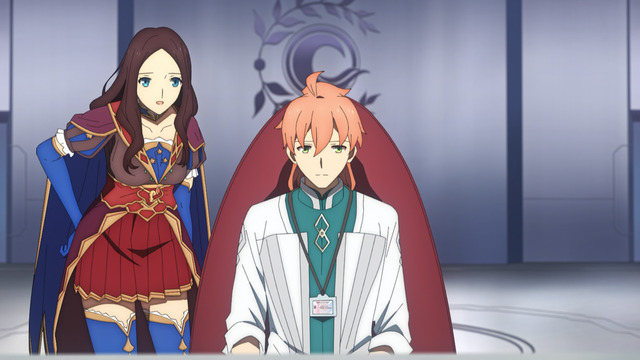
Leonardo never pulled up a chair of her own.
Secondly, none of that mattered, since the animation in Fate/Grand Order: Absolute Demonic Front Babylonia was frickin' amazing. It was literally so good that the story was inconsequential. It's worth watching just because it looks so good. I know in a post-Shirobako world we're not supposed to mention the B-word, but the anime adaptation of a franchise that prints money clearly had resources available to it, that, say, Cop Craft did not. The animation in Cop Craft gave me the impression people were doing the best they could in the face of adversity they did not control. The animation in Babylonia made me think animators were showing off and trying to outdo each other week after week.
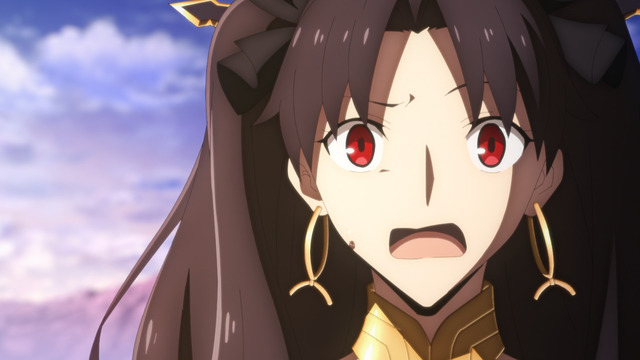
Believe it, baby.
Thirdly, these conditions serendipitously produced the best variant of Tohsaka Rin (Toosaka, whatever) of all time. Even better than Kaleido Ruby. I don't actually know why Ishtar looks like Rin from Fate/stay night. I literally could not break it down for you even though the show explicitly addressed it, and I've read the various summaries found in wikis for the game and whatnot. I find these explanations unsatisfactory. In any event, it doesn't matter. All you need to know is that Ishtar is a game-breaking home run. Oh, and Ereshkigal is okay, too.
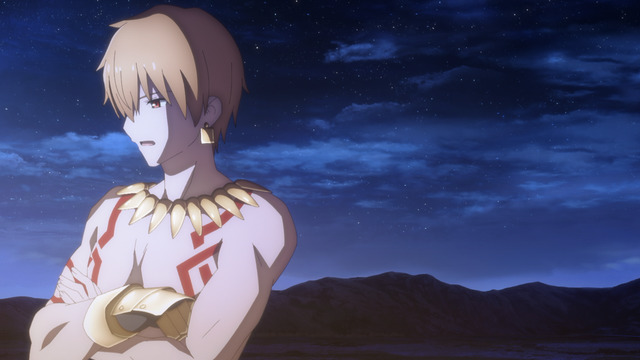
It turns out Gilgamesh was a lot more chill back in the day.
Finally, Fate/Grand Order: Zettai Majuu Sensen Babylonia was a really loud show. I don't think the show streamed with a discrete LFE channel (I didn't check), but it was at least mixed in such a way that every episode got considerable use out of my subwoofer. Planet With was sort of like this too, but it was sort of unpleasant during Planet With. On the other hand the deep impacts and 'splosions in Fate/Baby were really satisfying. I keep telling people not to skimp on the audio portion when setting up their preferred viewing space, whether it be a television or a computer. Hopefully, fans of Babylonia followed this practice as well. Totally worth it.
Posted in Fate/Grand Order: Zettai Majuu Sensen Babylonia | Tags: Air Power, All-Time Babes, Asakawa Yuu, Autumn 2019, AYAKO DOCTRINE, Big Fat Braids, Built for Sin, Fan Service, GAME-BREAKING HOME RUN, Games, Harem Comedy, Legs that go up to her neck, Sakamoto Maaya, Season Conclusion, Superlovely Character Designs, tsundere, TYPE-MOON, Ueda Kana, Video Games, war, War Is All Hell, Winter 2020 | Permanent Link
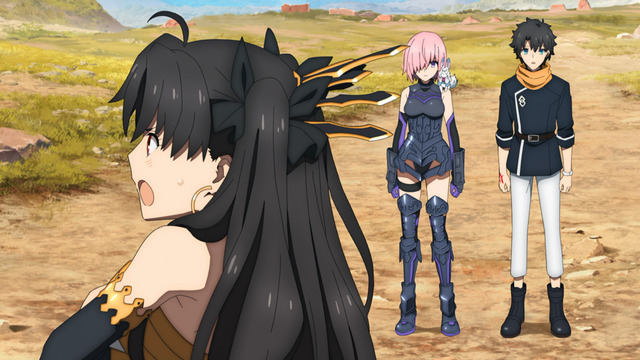
Potato-kun, are you wearing capri pants on this expedition?
The actual story and lore associated with Fate/Grand Order is incomprehensible to me because everything I know about it comes from secondary or tertiary sources such as people on the Twitter talking about the game, or from its fan art, or from people on the Twitter talking about the game's fan art. And while I have a semi-coherent understanding of the original Fate/stay night game, the currently airing Fate/Grand Order: Zettai Majuu Sensen Babylonia (Fate/Grand Order: Absolute Demonic Front Babylonia) anime is so removed from those origins that what I do know doesn't help at all. Compounding the problem, the anime seems to be adapting the seventh major arc of the FGO game, so there's an implied understanding that viewers should be familiar with the equivalent of six previous seasons. After the prologue and two proper episodes (plus the Fate/Grand Order -First Order- OVA), I'm still sort of lost.
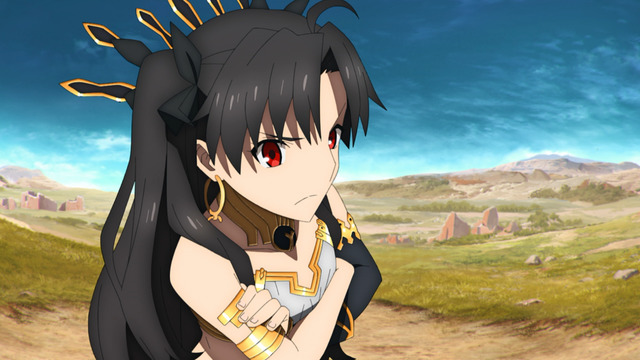
I can't rule out the possibility Marisa stole Ishtar's shit.
Thankfully, it seems recognizing references or knowing all the lore is not strictly necessary to enjoying the Fate/Grand Order: Zettai Majuu Sensen Babylonia anime. For one thing, it looks fantastic, and is probably the first solid example of a show where I can clearly identify 3DCG elements without having any of it bother me at all. (Okay, the lions bother me a little bit.) For example, flowing water actually looks as if it belongs in the same world. Additionally, the action scenes are entertaining, albeit rather busy. There is a lot of shit going on and a lot of cuts that seem designed to impress via fancy animation. Well, they are fancy, and I am impressed, but I think I'd prefer a less frantic style. Really, though, these are minor complaints on my part at best (even the stuff about the incomprehensible lore). As a matter of general principle, I'll almost certainly continue to watch Fate/Grand Order: Absolute Demonic Front Babylonia for as long as it runs, providing it periodically features Ishtar doing Ishtar-type things.
Posted in Fate/Grand Order: Zettai Majuu Sensen Babylonia | Tags: Asakawa Yuu, Autumn 2019, AYAKO DOCTRINE, Built for Sin, Fan Service, GAME-BREAKING HOME RUN, Games, Hair, Legs that go up to her neck, Sakamoto Maaya, Season Introduction, TYPE-MOON, Ueda Kana, Video Games | Permanent Link
|
|






